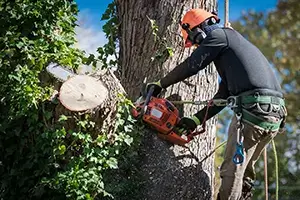The Signs of a Dead Tree
A dead or dying tree isn’t just an eyesore; it can also pose a safety risk to loved ones, friends, and passersby. Falling limbs can lead to costly damage to landscaping, structures, and fencing, and if windy weather or storms cause a dead tree to topple, then you may end up with roof damage or worse. Collinsville, Illinois homeowners should keep a careful watch on the trees on their properties and take action right away to remove any that are dead or decaying.
Spotting a Tree in Trouble
- Excessive leaf drop. One of the initial signs of sickness in trees is when they drop more leaves than expected during their seasonal cycle. If a tree suddenly lets go of a lot more leaves in the summer or spring, then it is probably in trouble.
- Leaf discoloration. Leaves that are discolored or develop a shriveled texture before the arrival of fall may signal a tree in distress.
- Falling branches. Bare branches with no leaves are a strong indicator that the tree is dead or is dying. If you look closely at fallen limbs or limbs removed during tree trimming, you may notice insect damage or decay.
- Holes in the trunk. Holes near the trunk’s bottom can be decay or rot, which is a typical sign of a dead or nearly dead tree.
- Brittle bark that flakes or bald spots in the bark. Normal, healthy bark has a pliable, soft texture. If it’s not, then something is amiss.
- Wood ears, mushrooms, and sogginess near the roots can indicate root system damage, often due to waterlogging or nicks and cuts from weed trimmers or mowers or even from fungal infestation. Root damage may also cause the tree to take on a bent stature, due to roots losing their strength to hold the tree upright.

Dead Tree Removal
If you have a dead tree, the smart thing to do is to remove it from your property right away. Professional tree removal services can take care of the problem more easily than the average homeowner and likely offer stump removal too, so you can readily replant a new tree to replace the old one.